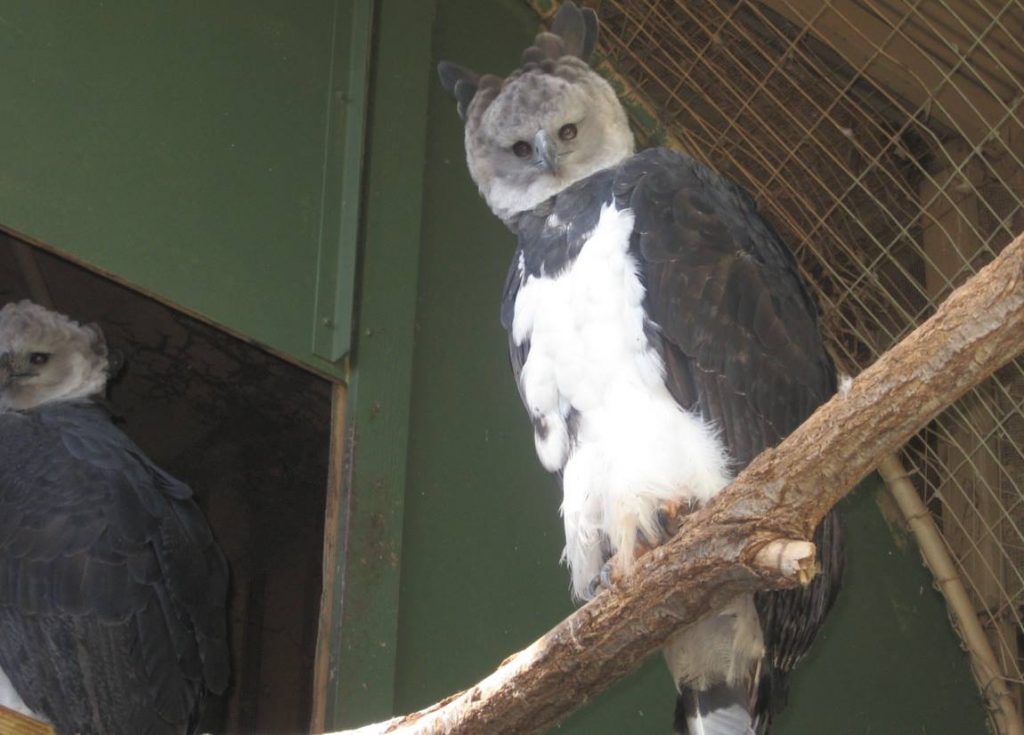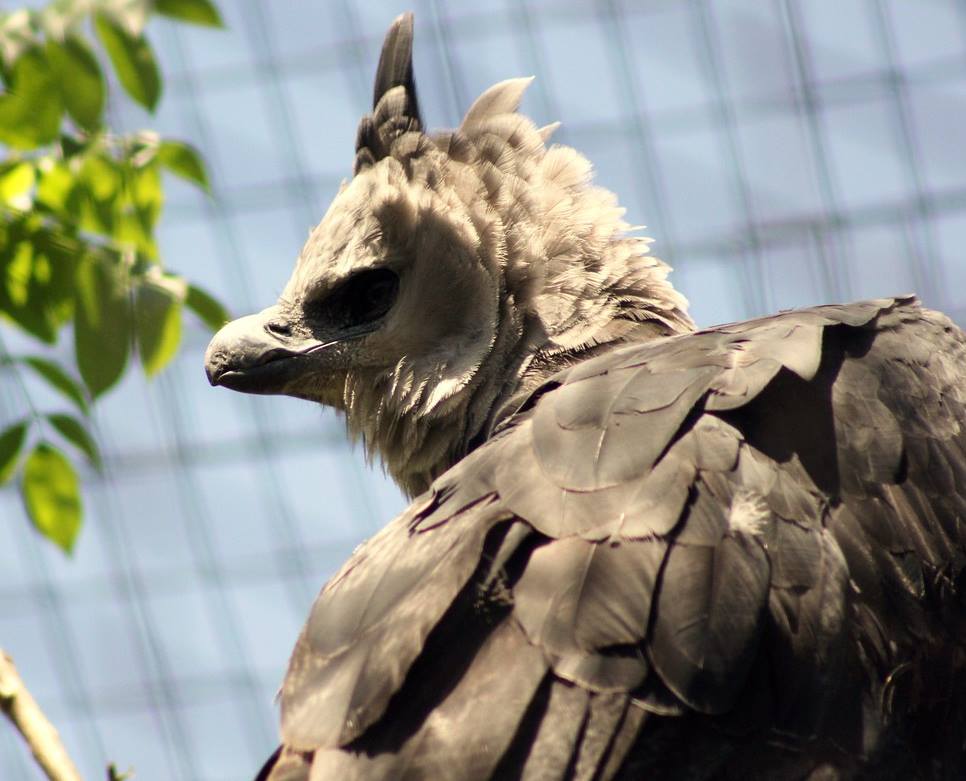
Among the extraordinary palette of unique bird species, one stands out with its terrifying size and ferocity - and that is the harpy eagle. Few other bird species can compete with the harpy eagle’s savage hunting methods.
The harpy eagle is the largest and most powerful raptor in the Americas; the actively hunting carnivores have no natural predators as adults. The harpy eagle can grow up to 42 inches long, with a wingspan that can reach 7-and-a-half feet and 3-4 inch long nails comparable to the size of a grizzly bear’s claws.
Harpy eagles have specialized in hunting monkeys and sloths; the birds can carry prey up to equal their own body weight. If their prey is too heavy, the birds will dismember the animal, tearing it into pieces at the killing site before returning to the nest.
These apex predators are even able to snatch their prey mid-flight. Though monkeys and sloths are their primary victims, harpy eagles have taken larger prey such as capybaras, peccaries, and deer and have even been recorded taking domestic livestock.
The dauntingly large talons of the harpy eagle can exert several hundred pounds of pressure, crushing the bones of its prey and instantly killing its victim.
The harpy eagle is able to turn its head upside down to get a better view of its future meal and can perch silently for up to 23 hours waiting to attack.

Image credits: cuatrok77
The Harpy Eagle is a magnificent bird of prey that resides in the tropical rainforests of Central and South America. Its impressive size and powerful build make it one of the largest and most formidable eagles in the world.
One of the most striking features of the Harpy Eagle is its strong wings, which span up to 2 meters (6.5 feet) in width. These wings are perfectly adapted for soaring through the dense rainforests of Central and South America, where the eagle is predominantly found. With its exceptional maneuverability and agility, the Harpy Eagle effortlessly navigates through the intricate canopy, making it a skilled hunter in its natural environment.
Equipped with sharp, curved talons that can measure up to 13 centimeters (5 inches) in length, the Harpy Eagle is a fearsome predator. Its talons are incredibly strong, capable of exerting an astonishing amount of force, enabling it to snatch and carry off prey that can weigh as much as half its own body weight. This remarkable strength allows the Harpy Eagle to capture a wide range of prey, including monkeys, sloths, iguanas, and even small deer.
The Harpy Eagle's hunting technique is characterized by stealth and surprise. It perches high in the forest canopy, patiently scanning the surroundings for any signs of movement. Once it spots its prey, the eagle swoops down with incredible speed, using its sharp talons to secure a firm grip on its victim. Its powerful beak, which can measure up to 5 centimeters (2 inches) in length, then delivers a swift and lethal blow, ensuring a quick and efficient kill.
Despite its impeccable hunting skills, the Harpy Eagle is not a threat to humans. In fact, it is a rather elusive and shy creature, preferring to avoid human contact whenever possible. Unfortunately, the Harpy Eagle faces numerous threats in the wild, primarily due to habitat loss and fragmentation caused by deforestation. Conservation efforts are crucial to protect this majestic bird and ensure its survival for future generations to admire and appreciate.
The harpy eagle is famous for its awe-inspiring speed, allowing it to reach incredible velocities as it soars through the sky. With its powerful wings and streamlined body, this majestic bird can reach speeds of up to 50 miles per hour, making it one of the fastest birds of prey in the world. This remarkable speed gives the harpy eagle a distinct advantage when it comes to hunting, as it can swiftly close in on its unsuspecting prey before they even have a chance to react.
In addition to its impressive speed, the harpy eagle possesses an extraordinary level of agility that is unmatched by many other birds. This agility is particularly evident when the eagle is navigating through the dense forest canopy, where it must maneuver through narrow gaps and dodge obstacles with precision. With its sharp eyesight and acute spatial awareness, the harpy eagle effortlessly weaves through the intricate network of branches and leaves, never missing a beat.
This exceptional agility is crucial for the harpy eagle's hunting success, as it allows the bird to pursue agile prey such as monkeys and sloths. These elusive creatures are known for their ability to swiftly move through the treetops, making them challenging targets for many predators. However, the harpy eagle's agility enables it to match the speed and agility of its prey, ensuring that it can effectively capture and subdue them.
Furthermore, the harpy eagle's agility also comes into play when it comes to capturing prey in challenging terrains. Whether it's swooping down from above or launching itself from a hidden perch, the eagle's nimble movements allow it to surprise its prey and execute precise attacks. This agility, combined with its powerful talons and strong grip, ensures that the harpy eagle can secure its prey firmly and prevent any chance of escape.
Overall, the harpy eagle's remarkable speed and agility are essential for its survival in its dense forest habitat. These attributes enable it to effectively hunt and capture prey, ensuring that it can sustain itself in the wild. With its unparalleled aerial prowess, the harpy eagle truly stands out as a master of the skies and a formidable predator in its ecosystem.
The largest harpy eagle ever recorded in history was an astonishing female specimen, standing at an impressive height of approximately 90 centimeters and weighing around 9 kilograms. This remarkable bird, a true giant of the skies, was fortunately found in the lush rainforests of Panama.
The scientific community was shocked by the discovery of this enormous harpy eagle, as it broke previous records and expanded our understanding of the species' potential size. With its towering stature and substantial weight, this extraordinary bird stood out among its peers, commanding attention and respect from all who saw it.
Deep within the heart of the Panamanian rainforests, this colossal bird showcases the grandeur and majesty of nature's creations. Its massive wingspan allowed it to effortlessly fly through the dense forest, navigating the intricate network of branches with grace and precision.
The harpy eagle, known for its distinctive and impressive appearance, has a regal crown of feathers on its head, resembling a majestic crown befitting its status as the queen of the skies. Its sharp and focused eyes exuded intelligence and power, reflecting the predatory prowess that lay within.
As an apex predator, this enormous harpy eagle ruled over its rainforest domain with unmatched authority. It primarily hunted and captured small to medium-sized mammals, such as monkeys and sloths, using its powerful talons. Its formidable beak, sharp and strong, served as a powerful weapon capable of tearing through flesh and bone effortlessly.
The discovery of this extraordinary harpy eagle not only fascinated the scientific community but also inspired wonder and admiration among nature enthusiasts worldwide. Its sheer size and magnificence served as a testament to the incredible diversity and beauty that exists within the natural world.
Although the harpy eagle’s natural habitat spreads throughout the tropical rainforests in Central and South America, spotting this bird in the wild is an unlikely adventure. Most of the time, they hide in the dense vegetation of upper rainforest canopies. Therefore, adventurers can rarely see them in wide-open spaces.
Some of the most well-known places to look out for harpy eagles include Brazil, Ecuador, Panama, and Peru. Even there, you must be really lucky to come across these elusive birds on a walk in the rainforest. The most likely location where you can spot a harpy eagle is an active nest site.
Due to their monogamous nature, harpy eagles are usually found in couples that stay together in nests, chirping at each other while building their homes and mating for life. The estimated life expectancy for a healthy harpy eagle spans from 25 to 35 years. For instance, you can spot a Peruvian harpy eagle’s nest high up the kapok trees of the Amazon rainforest.
While the harpy eagle has a significantly more muscular physique and unmatched strength in its rainforest habitat, the golden eagle has a slightly longer wingspan and is the main predator in open spaces.
On the one hand, the harpy eagle is endowed with a superior build and movability, making this species the master of dense forests. On the other hand, the golden eagle possesses the formidable speed and agility needed in open terrains.
Comparing the harpy eagle to the golden eagle in terms of strength is a difficult task with no specific answer, as both species are flawlessly adapted to their respective hunting styles and natural environments.
Image credits: gailhampshire
The population status of the harpy eagle has become near threatened as deforestation has threatened the survival of their species. Although there are considerable healthy populations of the Brazilian harpy eagle and other types of South American harpy eagle, most countries in Central America have listed this bird species as critically endangered and are making conservation efforts for it.
The IUCN warns of a continuous decline in the harpy eagle’s population. Their Red List of Threatened Species classifies this bird species as vulnerable, with an estimated global population size ranging from 100,000 to 250,000 mature individuals.
Forest fires, road construction in the rainforest, and slash-and-burn agriculture are some of the main threats to the harpy eagle’s survival. These factors lead to the destruction of rainforests, which are crucial for harpy eagles’ preservation. Therefore, the authorities must take concrete steps towards restoring the population of this vulnerable species, such as research and education programs, protecting ecosystems from deforestation, and forest restoration.
Image Source: The Next Gen Scientist
The harpy eagle is considered an apex predator in its natural habitat. According to some reports, juvenile harpy eagles may become prey for certain animals, such as jaguars. However, adult harpy eagles have very few natural predators.
Despite the harpy eagle’s position at the top of the food chain, humans are this majestic bird’s most dangerous enemy. In addition to the catastrophic effects of deforestation, human hunters shoot harpy eagles for sport.